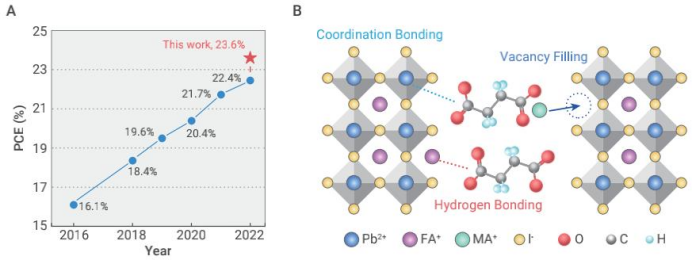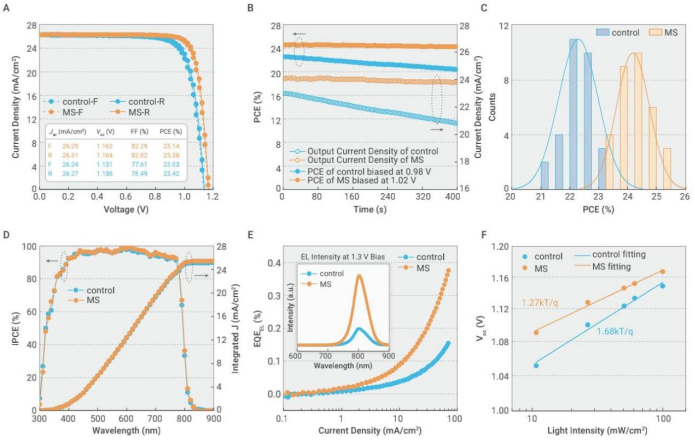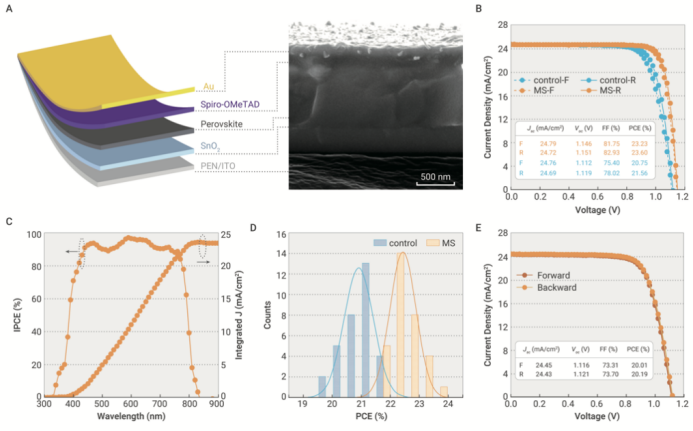Recently, Yi Chenyi’s research group from the Department of Electrical Engineering and Applied Electronics of Tsinghua University proposed a strategy to reduce defects and lattice micro-stress in perovskite films by introducing multifunctional additives, which realized a world record photoelectric conversion efficiency (PCE) of 23.6% for single-junction flexible perovskite solar cells (PSCs).
Organic-inorganic hybrid perovskite materials, with excellent light absorptivity, low manufacture cost, and that the flexible PSCs fabricated on flexible substrates are thin, shapeable and with high power-to-mass ratio, are extensively applicable in wearable electronics apparatus, unmanned aerial vehicles and photovoltaic building integration, and thus they attracted great attention in the academic field and industrial field. How to further improve the PCE and bending resistance of flexible apparatus is the key to their practical application.

Development trend of the highest efficiency of flexible PSCs and mechanism of additives
In this study, the authors designed a succinate additive introduced to the perovskite precursor to improve the quality of perovskite films and the performance of PSCs. SEM at high magnification found that the morphology of the perovskite film containing the succinate additive was significantly improved, the fluorescence intensity and fluorescence lifetime were significantly enhanced, and the film quality was significantly improved. Further NMR tests showed that the carboxylic acid group in the succinate anion can reach hydrogen bond with the formamidine cation in the perovskite lattice, and coordinate with the uncoordinated lead atom, meanwhile, the methylamine cations in succinate can also fill cation vacancies in the perovskite lattice. These interactions suppresses the defect states in the perovskite film and release the lattice microstress, resulting in significantly improving the quality and optoelectronic properties of the perovskite film.
The PSCs prepared by this method have excellent photoelectric properties, and the PCE of rigid cell devices is as high as 25.4% under AM1.5G standard illumination. The flexible devices fabricated on flexible substrates achieved the highest PCE of 23.6% (certified 22.5%), which is the highest efficiency record for single-junction flexible PSCs reported so far. Meanwhile, a flexible device with an area enlarged to 1 cm2 achieved a PCE above 20%.
It is worth mentioning that the introduction of additives strengthens the grains of the film, which greatly improves the bending resistance of the perovskite film. The flexible device can still maintain 85% of its initial PCE after being bent 10,000 times at a bending radius of 6 mm.

Effects of additives on photoelectric performance of PSCs (orange and blue are additive group and control group, respectively)

Device structure and optoelectronic properties of flexible PSCs (orange and blue are additive group and control group, respectively)
The comprehensive improvement of flexible device efficiency and bending resistance shows a good prospect for flexible PSCs in practical applications. This work was published under the title “Multifunctional succinate additive for flexible perovskite solar cells with more than 23% power conversion efficiency” in the integrated academic journal The Innovation by Cell Press. The first author of the paper is Li Minghao, a doctoral student admitted to EEA in 2018, the corresponding author is Yi Chenyi, associate professor of EEA, Tsinghua University, and the collaborators include Ding Liming, a researcher at the National Center for Nanoscience and Technology, and Dr. Wolfgang Tress from Zurich University of Applied Sciences, Switzerland, et al. The work is funded by the National Natural Science Foundation of China, the Independent Scientific Research Project of the State Key Laboratory of Power Systems, and the State Grid National Bioenergy Research Project.
Paper link:
https://www.sciencedirect.com/science/article/pii/S2666675822001060

















 News & Events
News & Events